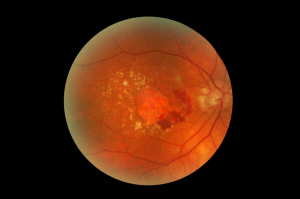Introduction
Certainly, macular degeneration, also termed age-related macular degeneration or AMD) is a loss of eyesight with age. As we age, the part of our retina ages more that was most active in terms of central vision (fovea or macula). It may be due to genetic predisposition that the macula can undergo an age-related degeneration. By all means, this happens more often in whites than in blacks, particularly in old age. That’s why this condition also has the name “senile macular degeneration”. The fact that AMD is more common in older people suggested to some that there may be an underlying hormone deficiency responsible for the development of AMD. Truly, Dr. S.A. Dzugan and Dr. G. Rozakis have proposed such a theory as Dr. Rozakis, an ophthalmologist noted an association of cholesterol elevation in the retinas of AMD patients, their blood cholesterol values and associated hormone deficiencies (Ref. 11).
Two forms of macular degeneration
It is important to realize that there are two forms how macular degeneration can occur, a dry macular degeneration and a wet macular degeneration. Specifically, with the common dry form there is an atrophic process happening in the macula, but there are no hemorrhages or exudates. In contrast, with the wet form of macular degeneration, which is more rare, a neovascularization (new blood vessels) process is happening in the choroidal membrane of the retina where the pigment cells are located.
Given that, this can lead to bleeding into the retina or to leakage of fluid (called exudate) underneath the retina. Finally, there is a threat of retinal detachment.
Signs and symptoms
As a result, there is vision loss without pain in both eyes. In addition, there are the characteristic findings as indicated under the links “dry macular degeneration” and “wet macular degeneration” above.
Another key point, in the beginning of this degenerative process there might be a visual problem on only one eye, which shows up as distortion on the Amsler’s chart. This is a square grid of lines, which the patient views at a distance of 35 cm (=12 inches) from the eyes. Notably, when there is a distortion of the grid, it is time to see an eye specialist on an urgent basis. With this in mind, there might be pigmentary lesions and drusen that alarm the eye physician that macular degeneration is imminent.
Diagnostic tests
Fluorescein angiograms can be used to study the absence (normal finding) or presence of a neovascular membrane formation underneath the retina. It is with the experience of the eye specialist, the fluorescein angiograms, the visual tests, slit lamp, direct and indirect ophthalmoscopy tests that the diagnosis of macular degeneration is made.
Treatment of AMD
If the eye-specialist identifies a neovascular network by fluorescein angiograms, the eye specialist may decide to do laser photocoagulation. This can stop further deterioration. Although the central vision will often be lost, there is still peripheral vision outside of the macula in the remainder of the retina. In other words, patients do not lose all of their sight. However, they will need support services of one or more of these
Prevention of AMD
When it comes to prevention of AMD the general opinion of eye specialists and physicians is that monitoring could be done for that. However, as I blogged in 2006 about this topic, there are 4 supplements that have been proven in a clinical trial (the Rotterdam study) to reduce AMD by 31% when taken in combination. They are vitamin E, zinc, vitamin C and beta-carotene.
References
2. Ferri: Ferri’s Clinical Advisor: Instant Diagnosis and Treatment, 2004 ed., Copyright © 2004 Mosby, Inc.
3. Rakel: Conn’s Current Therapy 2004, 56th ed., Copyright 2004 Elsevier
4. http://www.ncbi.nlm.nih.gov/pubmed/22696317 :Cochrane study update June 2012.
5. Spanish study, April 2012: low intake of lutein and zeaxanthin confirmed in 79% of patients with wet macular degeneration. http://www.ncbi.nlm.nih.gov/pubmed/22482894
6. Italian Study March/April 2012: http://www.ncbi.nlm.nih.gov/pubmed/22009916
7. Category 3 and 4 AMD would benefit from supplementation:http://www.ncbi.nlm.nih.gov/books/NBK84275/ (Jan. 2012).
8. http://ukpmc.ac.uk/abstract/MED/11297486 (2001)
9. http://www.ncbi.nlm.nih.gov/pubmed/22577773 (June 2012)
10. http://www.lef.org/magazine/mag2008/dec2008_Preventing-Macular-Degeneration_01.htm
11. http://agelesslifestyles.com/2010/11/many-health-problems-are-really-hormone-problems/







